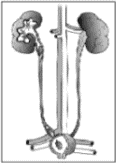Renal Stones
CIDPUSA for AUTOIMMUNE DISEASES , God our Guide
Sat, 31 May 2008 17:55:07
KidNey Stones
 Kidney stones in kidney, ureter, and bladder
Kidney stones in kidney, ureter, and bladder
Urolithiasis is the medical term used to describe stones occurring in the urinary tract. Other frequently used terms are urinary tract stone disease and nephrolithiasis. Doctors also use terms that describe the location of the stone in the urinary tract. For example, a ureteral stone (or ureterolithiasis) is a kidney stone found in the ureter. To keep things simple, however, the term "kidney stones" is used throughout this fact sheet.
Who gets kidney stones?
The number of people in the United States with kidney stones has been increasing over the past 30 years. The prevalence of stone-forming disease rose from 3.8 percent in the late 1970s to 5.2 percent in the late 1980s and early 1990s. White Americans are more prone to develop kidney stones than African Americans. Stones occur more frequently in men. The prevalence of kidney stones rises dramatically as men enter their 40s and continues to rise into their 70s. For women, the prevalence of kidney stones peaks in their 50s. Once a person gets more than one stone, others are likely to develop.
Most kidney stones pass out of the body without any intervention by a physician. Stones that cause lasting symptoms or other complications may be treated by various techniques, most of which do not involve major surgery. Also, research advances have led to a better understanding of the many factors that promote stone formation.
Introduction to the Urinary TractThe urinary tract, or system, consists of the kidneys, ureters, bladder, and urethra. The kidneys are two bean-shaped organs located below the ribs toward the middle of the back. The kidneys remove extra water and wastes from the blood, converting it to urine. They also keep a stable balance of salts and other substances in the blood. The kidneys produce hormones that help build strong bones and help form red blood cells.
Narrow tubes called ureters carry urine from the kidneys to the bladder, an oval-shaped chamber in the lower abdomen. Like a balloon, the bladder's elastic walls stretch and expand to store urine. They flatten together when urine is emptied through the urethra to outside the body.
What is a kidney stone?
A kidney stone is a hard mass developed from crystals that separate from the urine and build up on the inner surfaces of the kidney. Normally, urine contains chemicals that prevent or inhibit the crystals from forming. These inhibitors do not seem to work for everyone, however, so some people form stones. If the crystals remain tiny enough, they will travel through the urinary tract and pass out of the body in the urine without being noticed.
Kidney stones may contain various combinations of chemicals. The most common type of stone contains calcium in combination with either oxalate or phosphate. These chemicals are part of a person's normal diet and make up important parts of the body, such as bones and muscles.
A less common type of stone is caused by infection in the urinary tract. This type of stone is called a struvite or infection stone. A bit less common is the uric acid stone. Cystine stones are rare.
Please continue to next page
Autoimmune Diseases Treatment
IgA nephropathy
Goodpastures syndrome
IgA nephropathy Fish oil
Lupus nephropathy
Renal Failure
Hypertension & Kidney
Kidney Stones
Glomerulonephritis
Electrical Stimulation Therapy
magnets and ageing
Sand Bath for health
Glutathionesuper supplement
Sulphur Bath for Detox and health
MassageCancer Cure
Water chestnut amazing nutrition
Infants women omega-3 for healthy baby
Selenium the specialfood
Capsaicin
North American Herbs
Small fiber neuropathy
Gout Garlic
Magnetic deficiency
Pathology
Variants
CIDP
info
Fibromyalgia
IVIG
Diet
Burning Feet Home
Services Page
Chronic Fatigue
Autoimmune diseases
Prognosis
Bible healing
Celiac disease